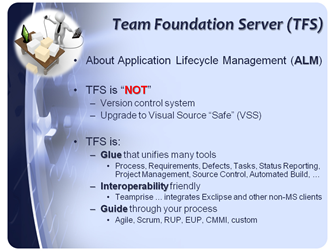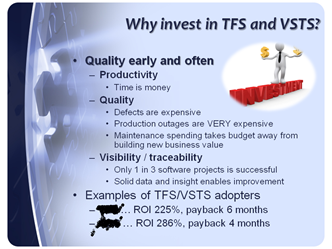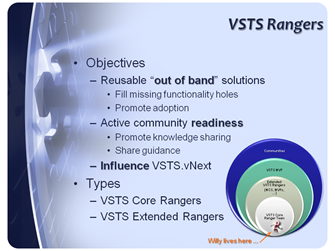Preparing for a TFS, VSTS and VSTS Rangers brownbag introduction session … so what?
 With the help of the colleagues Bill Maurer, Sam Guckenheimer, Sajee Mathew and Daryush Laqab I have created a set of slides to introduce the Visual Studio Team System product and the VSTS Rangers team at the Microsoft Canada Development Centre (MCDC) as a brownbag session. Working trough the slides, talking to other MVP and community colleagues and in particular reviewing a document that James Pereira, ‘the architect from South-Africa’, sent me I have come to the realisation that perhaps it would make sense to share the message I want to convey during the presentation with a broader audience.
With the help of the colleagues Bill Maurer, Sam Guckenheimer, Sajee Mathew and Daryush Laqab I have created a set of slides to introduce the Visual Studio Team System product and the VSTS Rangers team at the Microsoft Canada Development Centre (MCDC) as a brownbag session. Working trough the slides, talking to other MVP and community colleagues and in particular reviewing a document that James Pereira, ‘the architect from South-Africa’, sent me I have come to the realisation that perhaps it would make sense to share the message I want to convey during the presentation with a broader audience.
 One of the main questions is “What is TFS”?
One of the main questions is “What is TFS”?
As an ex- Team System MVP and VSTS Core Ranger my response to this question may be viewed critically by the reader. However, my personal opinion … not the official answer … is that neither TFS, or any other technology for that matter, is a silver bullet out of the box. If you are one of the people that are passionate about another technology or have managed to create a working solution by tying together a number of products, then it makes little sense to even consider another technology … be it TFS, VSTS or something else. If the oil tanker is on course, is making good progress and is guided by a happy and effective team, then it makes little send in ripping out the engine room and control room in the middle of the Pacific.
If, however, you are dabbling with software development life cycles, application lifecycle management or looking at ways of improving your software development ecosystem, then taking a peek at Team Foundation Server (TFS) is a good idea. TFS is all about application lifecycle management (ALM) and is the glue that unifies Visual Studio Team System, non-Microsoft tools such as Teamprise and Team System Widgets, and most importantly guides you through your selected process(es), i.e. Agile, Scrum, CMMI or a custom process.
It is not, however, an upgrade to Visual Studio Source Safe (VSS) or an alternative for any other version control system. While it packs a powerful, reliable and feature-rich version control system as a service, it is about all about ALM and not just version or source control.
Another worthy question is “What is VSTS”?
Visual Studio Team System (VSTS) is the Microsoft suite of tools designed to enable all ALM stakeholders, whether you are a developer, a tester, an architect, an analysts, a user, a sponsor, a manager or anyone else that has an interest in a software solution. At the heart sits Team Foundation Server (TFS), which we introduced above, delivering project management, work item tracking, version control, reporting, automated builds and process guidance services. TFS is surrounded by other tools such as Microsoft Office, Visual Studio Team Suite or a subset thereof Web Access and 3rd Party tools, such as the infamous Teamprise tools.
Some cool links:
- Team System Widgets
- Radio TFS … if you have a Zune, are the podcasts on it? If not, why not?
- Videos for Team System … if you have a Zune, are the videos on it? If not, why not?
- Team System Cafe
- Team System
 Probably one of the most important questions is “Why TFS / VSTS?”
Probably one of the most important questions is “Why TFS / VSTS?”
If you are looking to deliver quality early and often, believe that productivity is important and would like visibility across your solution lifecycle and stakeholders, then it is worthwhile investigating TFS and VSTS. When we consider that large organisations have managed to improve their RIO by 200%+ and get the payback in less than 1/2 a year, it seems to make perfect sense to download, install and start using Team System. Although this is a tempting step forward, I recommend that you work with some of the technology and ALM specialists from Microsoft, Microsoft Most Valued Professionals (MVP) or Communities to investigate your ecosystem and come up with a structured action plan. The implementation of Team System is not straight forward, especially in areas where existing processes are defined or development teams are busy trying to meet the normal tight and sheer impossible IT deadlines. Every minute you spend in front of the whiteboard discussing your environment and planning a Team System implementation is going to contribute nearly exponentially to your ROI and Payback.
Find information on Microsoft services at: Team System
Find the Team System MVP closest to you at: https://mvp.support.microsoft.com/communities/mvp.aspx?product=1&competency=Team+System
The majority of the session is based on the question “what is new in VSTS 2010”
Instead of summarising the content of my session, I would much rather point you at Brian Harry’s recent great treasure map “Team System 2010 Overview” … a great list and one that everyone should, sorry must, bookmark and observe.
To conclude, what are the VSTS Rangers?
 We have discussed this question on a number of occasions on this blog, so I will summarise it in my own words and as I see it from my personal perspective at this stage:
We have discussed this question on a number of occasions on this blog, so I will summarise it in my own words and as I see it from my personal perspective at this stage:
The VSTS Rangers is a [transparent] family comprised of Microsoft software engineers, Microsoft Most Valued Professionals (MVPs) and technology community leads who are pro-actively delivering missing features, reusable value add solutions, technology guidance, and are sharing knowledge with all stakeholders of VSTS.
I placed transparent in [] not to make it an optional characteristic, but to indicate that we are working hard to make the VSTS Rangers initiatives more transparent. This blog is filled with VSTS Rangers ramblings, the new Team System site highlights the VSTS Ranger initiatives and the new VSTS Rangers Project extranet sites connect all of the contributors … we are still in the early ages of complete transparency, but it is one of our top priorities and feedback with current initiatives has been very encouraging to date.
Team System 2010 is looming on the horizon and together with MVPs and community leads, the VSTS Core Rangers are hard at work to deliver guidance and support for the technology “before” it is released to market. This will empower and enable you to plan and make the right decisions proactively … there is nothing worse than getting an ALM solution up and running, convince teams to use the ecosystem for their strategic projects and then having to go “oh oh” when the product or guidance ships just too late.
Our objective is to ship guidance in the BETA 2 timeframe, giving you ample time to ponder over the next adventure in the age of Team System.
That’s just my 01 cent worth …
What’s next?
We are heads-down working on 6 new VSTS Rangers projects, we are evaluating VSTS 2010 on an on-going basis, even dog fooding some of the features to assist us in the new projects. I, for one, am MEGA excited about what is coming, what is and will be possible and the productivity features that are revolutionizing the software engineers desk. I often think back to the first editions of Visual Studio and the now crude development environments in the 80’s … there is no comparison and it also makes me scared of what will be coming down the pipeline in the future. Where are those energy drinks and tooth-picks (to keep eyes open), to allow us to explore and enjoy the IT world into the early hours of the morning?!?
In the meantime I wish everyone a safe and chocolate-abundant Easter weekend!